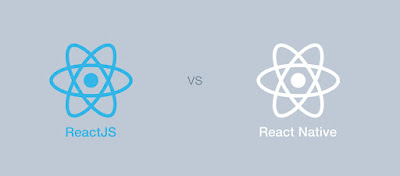Both ReactJS
and React Native are widely used open source JavaScript libraries. Both
libraries are developed and maintained by Facebook. But ReactJS is designed as
a view library. It accelerates development of web and mobile user interfaces
(UI) through virtual DOM, and reusable and customizable components. On the
other hand, React Native is developed as the next generation of ReactJS. The
cross-platform mobile app development tool enables developers to write native
mobile apps for iOS and Android platforms in JavaScript. That is why;
developers often find it daunting to differentiate between ReactJS and React
Native.
Understanding Important Differences between ReactJS and React Native
Design Rule
Both ReactJS
and React Native are developed and maintained by Facebook. But Facebook has
developed ReactJS as a robust view library and React Native as a cross platform
mobile app development frameworks. The features provided by ReactJS make it
easier for developers to handle view layers of web applications and mobile apps
efficiently. The programmers can also use the framework to create reusable
components for web and mobile applications. On the other hand, React Native
comes with features to accelerate native mobile app development for iOS and
Android platforms. It enables programmers to write iOS and Android apps in
JavaScript and compile native mobile components.
Creating and
Implementing UI Components
React Native
focus extensively on native mobile UI development. It enables developers to
enhance the native user experience of iOS and Android apps using native code.
The developers can improve the user experience delivered by an iOS app using
code written in Objective-C or Swift. Likewise, they can use Java code to
improve the native user experience of Android apps. But React Native requires
developers to build UI components for mobile apps by combining JavaScript and
ReactJS. It still used ReactJS as the default JavaScript library for
development of custom UI components. Hence, mobile app developers use ReactJS
as a part of React Native.
Virtual DOM
Most web
developers use ReactJS as the view in the model-view-controller (MVC)
architecture. The view library makes it easier for programmers to build web and
mobile UI components by rendering views. It further renders browser code
through virtual DOM. ReactJS improves the performance of web applications
significantly by updating the virtual DOM instead of the real DOM. But React
Native does not support virtual DOM. It uses the native APIs provided by
targeted mobile platforms to render various components of the mobile app. For
instance, it renders iOS app components through using Swift or Objective-C
APIs.
HTML
While using
ReactJS, programmers have to write code using JSX syntax. The JSX syntax is the
combination of HTML and JavaScript. The framework even allows developers to
embed HTML into the render function. The developers even have option to convert
HTML code into JSX using a JSX Transformer provided by ReactJS. But React
Native does not use HTML. While working with React Native, programmers have to
learn and use React Native syntax. The React Native syntax is completely
different from HTML syntax.
CSS
ReactJS
recommends programmers to use inline styles. It allows developers to specify a
CSS class through the classname attribute. Hence, the programmers have option
to write normal CSS code, and use the code to style various React components.
But React Native does not use CSS natively. While working with React Native,
programmers have to use special APIs to run standard features of CSS like
animations. The framework even allows developers to animate various components
using JavaScript.
Libraries
ReactJS is a
front-end framework, whereas React Native is a mobile framework. ReactJS
renders views through HTML. The developers can use ReactJS to create UI
components. But they have to compile the UI components through React Native to
build native iOS and Android apps. Hence, the JavaScript libraries do not
support the same libraries. The programmers have to select the libraries and
development tools according to their choice of framework. However, the
programmers have option to choose from an array of development tools compatible
with both ReactJS and React Native.
On the whole,
ReactJS and React Native complement each other. React Native is developed as
the next generation of ReactJS. It even uses ReactJS as the default JavaScript
library for building UI components for mobile apps. But the JavaScript
developers can use ReactJS to create web and mobile UI, whereas React Native
simplifies native iOS and Android development.

